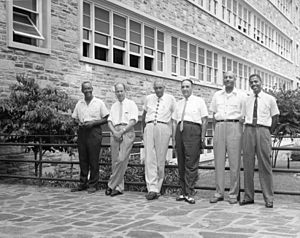Clarence F. Stephens facts for kids
Quick facts for kids
Clarence Francis Stephens
|
|
|---|---|

Stephens, second from right, at Morgan State University in the 1960s
|
|
| Born | 24 July 1917 |
| Died | 5 March 2018 |
| Alma mater | Johnson C. Smith University University of Michigan |
| Scientific career | |
| Institutions | Prairie View A&M University Morgan State University |
Clarence Francis Stephens (born July 24, 1917 – died March 5, 2018) was a very important African American mathematician. He was the ninth Black person to earn a special advanced degree called a Ph.D. in mathematics.
Dr. Stephens is famous for helping students and teachers at SUNY Potsdam create one of the best college math programs in the United States. He was honored in 2018 by "Mathematically Gifted & Black" for his amazing work.
Contents
Early Life and Education
Clarence Stephens was the fifth of six children. Sadly, he became an orphan when he was only eight years old. For his early schooling, he went to a special boarding school for African-Americans called Harbison Agricultural and Industrial Institute in Irmo, South Carolina.
He graduated from Johnson C. Smith University in 1938 with a degree in mathematics. He then continued his studies at the University of Michigan. There, he earned his master's degree in 1939 and his Ph.D. in 1944. His Ph.D. was for his work on "Non-Linear Difference Equations Analytic in a Parameter." He was the ninth African American to achieve this high level of math education.
After college, Dr. Stephens served in the U.S. Navy from 1942 to 1946. He worked as a Teaching Specialist. After his time in the Navy, he joined the math team at Prairie View A&M University. The very next year, in 1947, he was invited to teach math at Morgan State University.
From Research to Inspiring Teaching
When Dr. Stephens first started his career, he wanted to be a research mathematician. He chose to work at Morgan State University partly because it was close to a research library at Johns Hopkins University.
However, while at Morgan State, Dr. Stephens noticed that many students were not learning math well. He saw that they weren't inspired to learn. This made him change his focus. Instead of just doing research, he decided to become an excellent teacher. He wanted to help students truly understand and enjoy mathematics.
In 1953, he received a special Ford Fellowship. This allowed him to study for a year at the Institute for Advanced Study in Princeton, New Jersey.
Dr. Stephens stayed at Morgan State until 1962. During his time there, he started a program that had amazing results. Five of his students scored very high (91% to 99%) on a big math test called the Graduate Record Exam. Three of these students — Earl R. Barnes, Arthur D. Grainger, and Scott W. Williams — went on to earn Ph.D.s in mathematics. This was a big achievement for students from a Historically Black College.
In 1962, Stephens became a math professor at SUNY Geneseo. Then, in 1969, he moved to SUNY Potsdam. He became the head of the math department there until he retired in 1987.
During his time at SUNY Potsdam, the math department became famous across the country. It was known as a great place to learn math. For several years, the program produced many math majors. The teaching ideas Dr. Stephens used at Potsdam, and earlier at Morgan State, have been used by many other math departments. These methods have been written about in books and publications.
Dr. Stephens lived to be a 100 years old in July 2017. He passed away in March 2018.
The "Morgan-Potsdam Miracle" Teaching Method
Clarence Stephens's teaching method was so successful it was called the "Morgan-Potsdam Miracle." He believed that many students could learn advanced math if they had a lot of support and care.
His method focused on creating a special learning environment. This environment included:
- Teachers who were kind and well-trained.
- Lots of encouragement for students.
- Successful students who could be role models.
- Enough small successes to help students feel good about themselves.
- The strong belief that education is truly important.
Because of this method, Dr. Stephens was very successful at helping many students become math majors.
Awards and Honors
Dr. Stephens received many awards and honors for his important work:
- 1942: He was given a Julius Rosenwald Fellowship.
- 1943: He received a Ford Fellowship for his research at the Institute for Advanced Study.
- 1962: Governor J. Millard Tawes of Maryland honored him for his contributions to education.
- 1976-77: He received the SUNY Chancellor's Award for Excellence in Teaching.
- 1987: Governor Mario Cuomo of New York honored him for his contributions to education.

